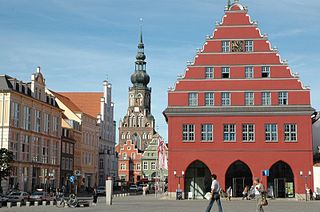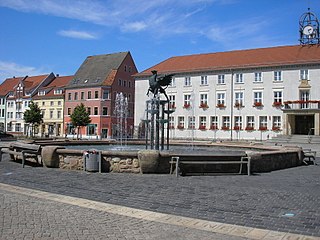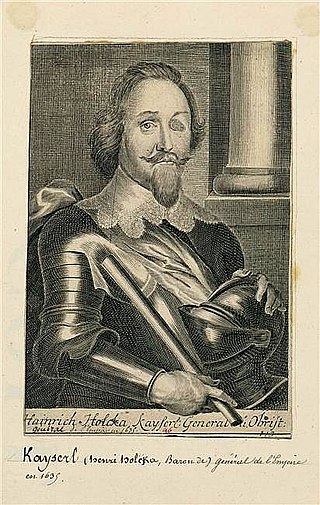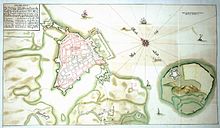
Stralsund, officially the Hanseatic City of Stralsund, is the fifth-largest city in the northeastern German federal state of Mecklenburg-Western Pomerania after Rostock, Schwerin, Neubrandenburg and Greifswald, and the second-largest city in the Pomeranian part of the state. It is located at the southern coast of the Strelasund, a sound of the Baltic Sea separating the island of Rügen from the Pomeranian mainland.

Greifswald, officially the University and Hanseatic City of Greifswald is the fourth-largest city in the German state of Mecklenburg-Western Pomerania after Rostock, Schwerin and Neubrandenburg. In 2021 it surpassed Stralsund for the first time, and became the largest city in the Pomeranian part of the state. It sits on the River Ryck, at its mouth into the Danish Wiek, a sub-bay of the Bay of Greifswald, which is itself a sub-bay of the Bay of Pomerania of the Baltic Sea.

Anklam is a town in the Western Pomerania region of Mecklenburg-Vorpommern, Germany. It is situated on the banks of the Peene river, just 8 km from its mouth in the Kleines Haff, the western part of the Stettin Lagoon. Anklam has a population of 12,177 (2021) and was the capital of the former Ostvorpommern district. Since September 2011, it has been part of the district of Vorpommern-Greifswald.

Demmin is a town in the Mecklenburgische Seenplatte district, Mecklenburg-Western Pomerania, Germany. It was the capital of the former district of Demmin.

The Scanian War was a part of the Northern Wars involving the union of Denmark–Norway, Brandenburg and Sweden. It was fought from 1675 to 1679 mainly on Scanian soil, in the former Danish and Norway provinces along the border with Sweden, and in Northern Germany. While the latter battles are regarded as a theater of the Scanian war in English, Danish, Norwegian and Swedish historiography, they are seen as a separate war in German historiography, called the Swedish-Brandenburgian War.

Arvid Wittenberg or Arvid Wirtenberg von Debern, Swedish count, field marshal and privy councillor. Born in Porvoo, Finland, died in prison in Zamość, Poland, 7 September 1657. Arvid Wittenberg preferred call himself by the original Wittenberg family name, which was Wirtenberg von Debern.

The siege of Stralsund was a siege laid on Stralsund by Albrecht von Wallenstein's Imperial Army during the Thirty Years' War, from 13 May 1628 to 4 August 1628. Stralsund was aided by Denmark and Sweden, with considerable Scottish participation. The lifting of the siege ended Wallenstein's series of victories, and contributed to his downfall. The Swedish garrison in Stralsund was the first on German soil in history. The battle marked the de facto entrance of Sweden into the war.
The Battle of Wolgast was an engagement in the Thirty Years' War, fought on 22 August (O.S.) or 2 September (N.S.) 1628 near Wolgast, Duchy of Pomerania, Germany.
The County of Gützkow was a county in the Duchy of Pomerania in the High Middle Ages. It was established in 1129 from the Castellany of Gützkow. Following the death of its last count in 1359, it was reestablished into the Vogtei Gützkow.

The Treaty of Stettin or Alliance of Stettin was the legal framework for the occupation of the Duchy of Pomerania by the Swedish Empire during the Thirty Years' War. Concluded on 25 August (O.S.) or 4 September 1630 (N.S.), it was predated to 10 July (O.S.) or 20 July 1630 (N.S.), the date of the Swedish Landing. Sweden assumed military control, and used the Pomeranian bridgehead for campaigns into Central and Southern Germany. After the death of the last Pomeranian duke in 1637, forces of the Holy Roman Empire invaded Pomerania to enforce Brandenburg's claims on succession, but they were defeated by Sweden in the ensuing battles. Some of the Pomeranian nobility had changed sides and supported Brandenburg. By the end of the war, the treaty was superseded by the Peace of Westphalia (1648) and the subsequent Treaty of Stettin (1653), when Pomerania was partitioned into a western, Swedish part, and an eastern, Brandenburgian part.

The Peace of Lund, signed on 16 September (O.S.) / 26 September 1679, was the final peace treaty between Denmark–Norway and the Swedish Empire in the Scanian War.

Philipp Julius was duke of Pomerania in the Teilherzogtum Pomerania-Wolgast from 1592 to 1625.

The capitulation of Franzburg was a treaty providing for the capitulation of the Duchy of Pomerania to the forces of the Holy Roman Empire during the Thirty Years' War. It was signed on 10 November (O.S.) or 20 November (N.S.) 1627 by Bogislaw XIV, Duke of Pomerania and Hans Georg von Arnim, commander in chief of an occupation force belonging to the army of Ferdinand II, Holy Roman Emperor, led by Albrecht von Wallenstein. While the terms of the capitulation were unfavourable for the Duchy of Pomerania already, occupation became even more burdensome when the occupation force did not adhere to the restrictions outlined in Franzburg. Stralsund resisted with Danish, Swedish and Scottish support, another Danish intervention failed. Imperial occupation lasted until Swedish forces invaded in 1630, and subsequently cleared all of the Duchy of Pomerania of imperial forces until 1631.

Heinrich Holk was a Danish-German mercenary in both Christian IV of Denmark's and Albrecht von Wallenstein's service during the Thirty Years' War.

Sten Svantesson Bielke, also Steno Bielke, was a statesman of the Swedish Empire.

The Treaty or Peace of Saint-Germain-en-Laye of 19 June (OS) or 29 June (NS) 1679 was a peace treaty between France and the Electorate of Brandenburg. It restored to France's ally Sweden her dominions Bremen-Verden and Swedish Pomerania, lost to Brandenburg in the Scanian War. Sweden ratified the treaty on 28 July 1679.

The siege of Stralsund lasted from 24 July to 24 August, 1807, and saw troops from the First French Empire twice attempt to capture the port city from Lieutenant General Hans Henric von Essen's 15,000-man Swedish garrison. Early that year, Marshal Édouard Adolphe Casimir Joseph Mortier blockaded the city for two months before he was called elsewhere. In his absence, the Swedes drove back the inferior blockading force. After Mortier returned and pushed Essen's troops back in turn, the two sides quickly concluded an armistice. The truce was later repudiated by King Gustav IV Adolf of Sweden, and Marshal Guillaume Marie Anne Brune then led 40,000 French, German, Spanish, Italian and Dutch soldiers against the fortress. Fearfully outnumbered, the Swedes abandoned the Baltic Sea port of Stralsund to the Franco-Allies in the action during the War of the Fourth Coalition, part of the Napoleonic Wars. As a consequence, Sweden also lost the nearby island of Rügen.

The Swedish wars on Bremen were fought between the Swedish Empire and the Hanseatic town of Bremen in 1654 and 1666. Bremen claimed to be subject to the Holy Roman Emperor, maintaining Imperial immediacy, while Sweden claimed Bremen to be a mediatised part of her dominions of Bremen-Verden, themselves territories immediately beneath the emperor. Sweden was able to gain some territory, but despite forcing a formal oath of allegiance on Bremen, did not gain control of the town.

The establishment of a dominium maris baltici was one of the primary political aims of the Danish and Swedish kingdoms in the late medieval and early modern eras. Throughout the Northern Wars the Danish and Swedish navies played a secondary role, as the dominium was contested through control of key coasts by land warfare.

FältmarskalkCarl Gustaf Wrangel was a Swedish Statesman and Military Commander who commanded the Swedish forces in the Thirty Years' War, as well as the Torstenson, Bremen, Second Northern and Scanian Wars.




















